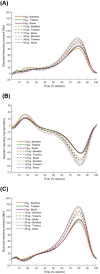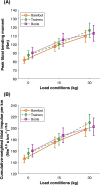Footwear has a modifying effect on tibial loading during military weight carriage
- PMID: 40691199
- PMCID: PMC12280124
- DOI: 10.1038/s41598-025-11202-8
Footwear has a modifying effect on tibial loading during military weight carriage
Abstract
This study investigated how different footwear conditions influence tibial loading across incremental load carriage during walking. Ten military-trained male participants completed walking trials under three weight conditions (0, 15, and 30 kg) and three footwear conditions (barefoot, trainers, and military boots) at 1.67 m/s. Kinematic (120 Hz) and kinetic (1200 Hz) data were collected using motion capture and force plates. Tibial loading was estimated via musculoskeletal modeling and beam theory, focusing on peak tibial bending moments and cumulative-weighted tibial impulse. A two-way repeated measures ANOVA ([Formula: see text]) examined main effects and interactions of load and footwear. Post hoc pairwise comparisons with Bonferroni corrections ([Formula: see text]) identified significant differences. A significant interaction effect was observed for peak tibial bending moments and cumulative-weighted tibial impulse per kilometer ([Formula: see text]). In trainers, tibial loading increased progressively across all loads (0 kg < 15 kg < 30 kg, all [Formula: see text]). In military boots, loading increased from 0 to 15 kg ([Formula: see text]) but not between 15 and 30 kg. Weight carriage increased tibial loading, but footwear modified this relationship. Military boots showed no significant change between 15 and 30 kg. These findings suggest implications for tibial stress injury, though further research is needed.
Keywords: Bending moment; Cumulative loading; Load carriage; Military boots; Tibial stress injury; Walking.
© 2025. The Author(s).
Conflict of interest statement
Declarations. Competing interests: The authors declare no competing interests.
Figures




Similar articles
-
Impact attenuation during weight bearing activities in barefoot vs. shod conditions: a systematic review.Gait Posture. 2013 Jun;38(2):175-86. doi: 10.1016/j.gaitpost.2012.11.017. Epub 2012 Dec 11. Gait Posture. 2013. PMID: 23245643
-
Running shoes for preventing lower limb running injuries in adults.Cochrane Database Syst Rev. 2022 Aug 22;8(8):CD013368. doi: 10.1002/14651858.CD013368.pub2. Cochrane Database Syst Rev. 2022. PMID: 35993829 Free PMC article.
-
Barefoot vs common footwear: A systematic review of the kinematic, kinetic and muscle activity differences during walking.Gait Posture. 2015 Sep;42(3):230-9. doi: 10.1016/j.gaitpost.2015.05.019. Epub 2015 Jun 3. Gait Posture. 2015. PMID: 26220400
-
The effect of weapon handling during load carriage across a range of military-relevant walking speeds.Ergonomics. 2025 Aug;68(8):1260-1273. doi: 10.1080/00140139.2024.2400125. Epub 2024 Sep 12. Ergonomics. 2025. PMID: 39264271
-
Effect of increased running speed and weight carriage on peak and cumulative tibial loading.Scand J Med Sci Sports. 2023 Dec;33(12):2516-2523. doi: 10.1111/sms.14476. Epub 2023 Aug 29. Scand J Med Sci Sports. 2023. PMID: 37642291
References
-
- Nunns, M. et al. Four biomechanical and anthropometric measures predict tibial stress fracture: a prospective study of 1065 royal marines. Br. J. Sports Med.50, 1206–1210. 10.1136/bjsports-2015-095394 (2016). - PubMed
-
- Knapik, J. J., Reynolds, K. L. & Harman, E. Soldier load carriage: Historical, physiological, biomechanical, and medical aspects. Mil. Med.169, 45–56. 10.7205/milmed.169.1.45 (2004). - PubMed
-
- Milgrom, C. et al. Stress fractures in military recruits. a prospective study showing an unusually high incidence. J. Bone Joint Surg. British Vol.67, 732–735. 10.1302/0301-620x.67b5.4055871 (1985). - PubMed
-
- Cosman, F. et al. Determinants of stress fracture risk in united states military academy cadets. Bone55, 359–366. 10.1016/j.bone.2013.04.011 (2013). - PubMed
MeSH terms
LinkOut - more resources
Full Text Sources
Medical

